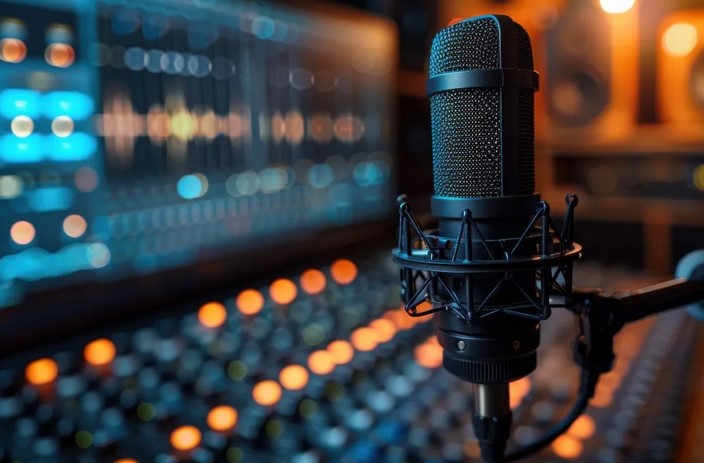
In the fast-paced world of media production, audio quality plays a critical role in delivering a professional and immersive experience for the audience. Whether it’s for film, television, podcasts, music production, or video games, the clarity, depth, and fidelity of the audio are paramount to conveying the intended message. One of the most crucial components in achieving high-quality sound is selecting the right equipment. Good recording microphones are at the heart of every successful audio production, offering a range of features that enhance the recording process and ensure optimal sound capture. This article will explore what makes a microphone “good,” why the right microphone matters, and how to select the perfect microphone for your media production needs.
The Importance of Good Recording Microphones in Media Production
Audio has a profound impact on the overall quality of media productions. In fact, poor sound can ruin an otherwise stellar video or music production. For example, whether you’re shooting a film or recording a podcast, capturing clear, distortion-free audio is essential to maintaining the listener’s attention and preserving the integrity of the content. Microphones, as the primary tool for capturing sound, are key players in this process.
Good recording microphones are designed to pick up sound accurately and efficiently, making sure that the nuances of the voice or instrument are fully captured without distortion or unwanted background noise. Whether in a controlled studio environment or a more dynamic, real-world setting, the microphone you choose can have a significant impact on the final product. From capturing the crisp clarity of a spoken word in a podcast to the rich, layered tones of an orchestral composition, selecting the right microphone can elevate your project to professional levels.
Types of Microphones: Choosing the Right One for Your Production
Not all microphones are created equal, and the type of microphone you choose depends largely on the specific needs of your production. Here’s a breakdown of some common microphone types used in various media production fields:
1. Dynamic Microphones
Dynamic microphones are known for their durability and versatility. They are typically used in live settings or environments where there is a lot of background noise. These microphones are less sensitive than condenser microphones, making them great for applications such as live sound reinforcement, broadcasting, or capturing audio in a noisy setting. A well-known dynamic microphone is the Shure SM7B, widely used in podcasting and broadcasting for its ability to reject ambient noise while maintaining a balanced, clear sound.
2. Condenser Microphones
Condenser microphones are ideal for studio settings and are often preferred for recording vocals, instruments, and voiceovers. They are much more sensitive than dynamic microphones, allowing them to capture the nuances of the audio with incredible detail. Condenser microphones are available in various forms, including large-diaphragm and small-diaphragm versions. Large-diaphragm condensers are popular for vocal recording, while small-diaphragm versions are often used for capturing acoustic instruments or room ambiance. The Audio-Technica AT2020 is an affordable condenser microphone that delivers high-quality recordings, making it a staple in home studios.
3. Ribbon Microphones
Ribbon microphones are a type of condenser microphone, but they use a thin metal ribbon to capture sound, which gives them a unique tonal quality. These microphones tend to have a vintage sound, often described as warm or smooth. They are best suited for studio environments with controlled acoustics, where their precise and natural sound can truly shine. Ribbon microphones are often used for capturing vocals or orchestral music but require careful handling as they are more delicate than dynamic or condenser microphones.
4. Lavalier Microphones
Lavalier microphones, also known as lapel mics, are small, clip-on microphones that are typically used in video production and broadcasting. These microphones are particularly useful for capturing dialogue in interviews, presentations, or live events. Lavalier microphones provide hands-free operation, making them ideal for scenarios where the speaker needs to move around or be mobile. The Rode Lavalier GO is a popular option for vloggers and content creators who need high-quality, portable sound recording.
5. Shotgun Microphones
Shotgun microphones are highly directional and are designed to capture sound from a specific source while rejecting sound from the sides and rear. This makes them ideal for outdoor or on-location shoots, where background noise can be an issue. They are commonly used in film and television production for capturing dialogue from a distance without picking up excessive ambient noise. The Sennheiser MKH 416 is a highly regarded shotgun microphone often used by film crews and broadcasters.
Key Features to Look for in Good Recording Microphones
When selecting a good recording microphone for media production, there are several important factors to consider. These factors will ensure that you get the best sound quality possible for your project. Here are the most critical features to keep in mind:
1. Frequency Response
The frequency response of a microphone determines the range of sound frequencies it can capture. A microphone with a broad frequency response will be able to pick up a wider range of sounds, from deep bass to high-pitched treble. For vocal recordings, a frequency response that captures the full range of human speech (typically between 80Hz and 15kHz) is important for achieving natural-sounding audio.
2. Polar Pattern
The polar pattern of a microphone defines the direction from which it captures sound. Some microphones, such as omnidirectional microphones, capture sound from all directions, while others, like cardioid microphones, focus on sound from one direction (usually from the front of the microphone). Choosing the right polar pattern depends on your recording environment and how much background noise you want to reject.
3. Sensitivity and Noise Rejection
A good recording microphone should be able to pick up the desired sound clearly while minimizing background noise. For studio recordings, a microphone with high sensitivity is essential for capturing intricate details, while microphones with better noise rejection capabilities are useful for environments with a lot of ambient noise. Choosing a microphone with the appropriate sensitivity will allow you to get the clearest sound possible, whether recording in a controlled environment or on location.
4. Durability
Durability is an important factor, particularly for microphones used in live events or outdoor recordings. A microphone that can withstand wear and tear, bumps, and temperature fluctuations will be essential for maintaining consistent performance. Dynamic microphones are often the most durable, whereas condenser and ribbon microphones may require more careful handling.
The Future of Good Recording Microphones: Trends and Innovations
The market for recording microphones continues to evolve, with new technologies and innovations enhancing the capabilities of these essential tools. One of the most notable advancements is the development of wireless microphone systems, which allow for greater mobility and flexibility in both studio and field recordings. Advances in digital signal processing (DSP) are also helping microphones capture cleaner, more accurate sound, with features such as real-time noise cancellation and improved feedback control.
The future of good recording microphones also lies in the integration of artificial intelligence (AI) and machine learning. These technologies can help optimize the recording process by automatically adjusting gain levels, reducing distortion, and enhancing sound clarity. With the continued rise of remote work and virtual content creation, microphones with built-in audio processing capabilities may become the standard for both amateur and professional creators alike.
Good recording microphones are the cornerstone of high-quality audio in media production. From capturing the crispness of a singer’s voice to the subtle details of a sound effect, the right microphone can transform the final product, ensuring that audio stands out and supports the narrative or atmosphere of a project. Whether you’re a musician, filmmaker, podcaster, or content creator, investing in the right equipment is key to achieving professional results. As technology advances, the possibilities for microphones continue to grow, offering creators even more powerful tools to elevate their sound. In the ever-competitive world of media production, selecting the best good recording microphones will always be an investment worth making for any serious professional.
